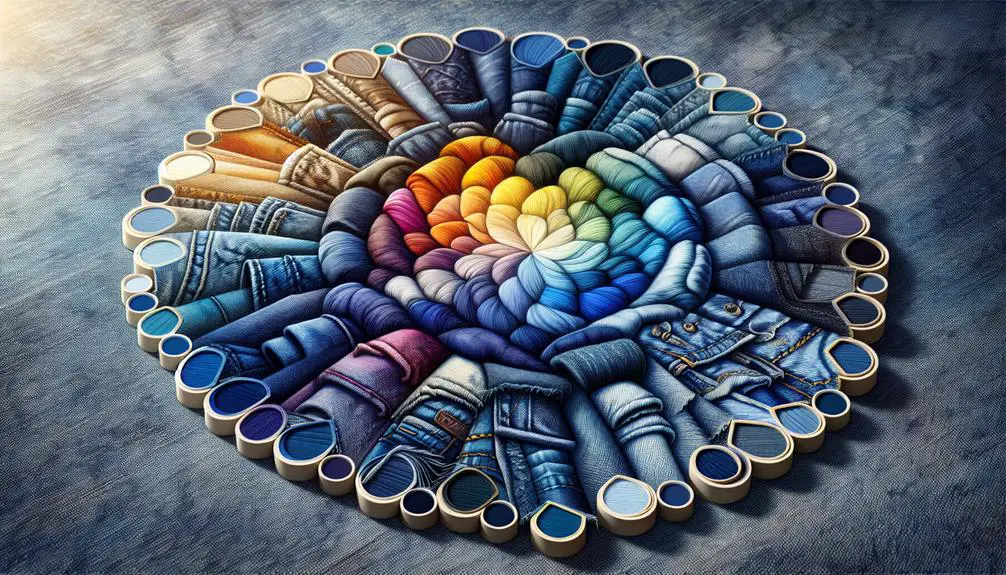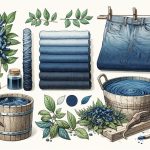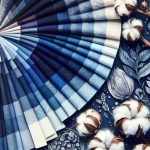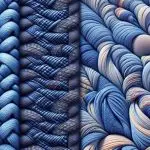So, I've been pondering whether denim is more of a color or a material. Honestly, it's primarily known as a tough, durable fabric that's a staple in wardrobes worldwide, thanks to its cotton twill weave. Yet, it's hard to ignore how the classic blue shade, derived from indigo dye, has almost become synonymous with the term "denim." This got me thinking about its vast color spectrum and how that influences our perception. Isn't it intriguing how a single word can encompass both a material and a color? Stick around, and let's unpack the layers behind denim's identity together.
Table of Contents
Key Takeaways
- Denim is primarily a durable fabric made from cotton, known for its strength and longevity.
- The term "denim" refers to the material itself, not a color.
- Denim fabric is traditionally dyed with indigo, giving it the classic blue color associated with jeans.
- The color spectrum of denim extends beyond blue to include black, grey, and white due to various dyeing techniques.
- While "denim" might evoke a specific shade of blue, it accurately describes the twill-woven fabric rather than a color.
Understanding Denim
At its core, denim's a tough fabric made mostly from cotton, boasting a distinctive blue hue thanks to the indigo-dyed warp threads. This isn't just any cotton fabric, though. We're talking about a durable fabric with a twill weave that gives it that classic, can-handle-anything vibe. It's all about the indigo dye when it comes to that iconic blue color. This isn't just for looks; it's about crafting a denim material that stands the test of time and fashion whims.
Now, you might think denim is all about jeans production, and you wouldn't be wrong. But it's so much more. This fabric's versatility stretches way beyond just your favorite pair of blues. We're diving into a world where denim becomes purses, skirts, coats – you name it. Its durable nature means it's up for nearly any fashion challenge.
Understanding denim's about recognizing its roots in quality cotton fabric, its unique twill weave, and how that deep indigo dye works its magic. It's a material that's crafted for those who demand durability without skimping on style. So, when we talk about denim, remember, it's not just fabric; it's a canvas for versatile applications in our everyday wardrobe.
The History of Denim
Let's talk about how denim started and changed over time.
It's crazy to think it kicked off in the 1600s in France and has roots in both Europe and America.
I'm excited to explore how this material evolved from manual worker gear to a global fashion staple.
Denim's Early Beginnings
Interestingly, denim's journey began in the 1600s in France, where it was first known as a twill weave called serge de Nîmes. This fabric's story is deeply intertwined with European and American textile traditions.
While France was making its mark with serge de Nîmes, over in Italy, specifically in Genoa, a similar fabric known as Bleu de Gênes was being used by manual workers. The term 'denim' itself evolved from 'de Nîmes,' reflecting its origins.
Fast forward to the early 1700s, textile mills in the United States started adopting this durable twill weave. But they put their own spin on it by using locally sourced cotton. This cross-pollination of ideas between the continents showcases how denim was born from a rich tapestry of European traditions before firmly planting its roots in American soil.
Evolution Across Centuries
Having explored denim's early roots, we now turn our focus to its dramatic evolution over the centuries. From its humble beginnings as serge de Nimes, this fabric took a significant twist, merging European and American textile traditions into something uniquely enduring.
The indigo dyeing method introduced an element of grace in aging, allowing for personalized wear patterns that made each piece uniquely its own. Meanwhile, the discovery of Bleu de Gnes highlighted denim's global journey.
As it evolved, the introduction of synthetic fibers for stretch and durability ensured its status as a durable and versatile material. This blend not only maintained its iconic look but also enhanced its utility, making denim an enduring symbol of adaptability and personal expression through the ages.
Denim's Color Spectrum
Denim's not just your classic blue; it spans a whole spectrum from deep indigo to light blue, and even rocks in black, grey, and white. Traditionally, blue dye, particularly indigo, was the go-to for dyeing denim fabrics. This method has given us the iconic shades of blue that immediately come to mind when we think of denim. But it's not just about sticking to one hue; the dyeing process allows for a wide color spectrum, introducing a variety of different types of denim that cater to any style.
The thing is, denim's versatility in color is achieved through various dyeing techniques. These methods can produce everything from the darkest indigo to the softest baby blue, and let's not forget about denim in black, grey, and white. These colors add a whole new dimension to the denim game, allowing for endless mixing and matching possibilities.
Denim Fabric Production
While we delve into how denim fabric gets made, it's crucial to note that the process starts with cleaning cotton fibers, which are then mixed with materials like polyester before being dyed with indigo to achieve that classic color. This blend, often a polyester blend, not only adds durability but also caters to the evolving needs of consumers who look for stretch in their denim.
Here's a quick breakdown of what goes into making denim fabric:
- Cotton Fibers: The base of all denim fabric, providing that natural feel and breathability.
- Indigo Dyeing: Gives denim its iconic blue color, with variations in shade depending on the dyeing process.
- Twill Weaving: This technique intertwines the dyed and undyed fibers in a way that enhances the fabric's strength and durability.
- Synthetic Fibers: Adding materials like polyester to the mix for that extra stretch and durability.
- Finishing Process: A crucial step where the denim is treated to enhance its resistance to abrasion and ensure it meets the specific needs of its intended use.
Understanding these steps not only helps in appreciating the complexity behind your favorite pair of jeans but also highlights the craftsmanship involved in producing denim fabric that's built to last.
Denim Across Cultures
Across the globe, denim's versatility unites countless cultures, embodying styles that range from traditional to modern. This fabric has a knack for blending in, no matter where you are. From the bustling cities in Asia to the laid-back towns in America, denim fabric has woven itself into the very fabric of our lives, reflecting diverse cultural influences at every turn.
In some places, you'll find denim seamlessly incorporated into traditional attire, a testament to its adaptability in diverse cultural contexts. It's fascinating how a single material can hold its own, whether it's paired with intricate patterns in Africa or used in the minimalist designs of Europe. This chameleon-like quality has cemented denim's place as a global fashion staple.
The way denim production varies from one region to another speaks volumes about its enduring popularity. Every corner of the world has its own take, adding a unique twist to both contemporary and traditional attire. This evolution across societies showcases not just denim's versatility, but also its ability to bridge cultures.
It's clear that denim isn't just another trend; it's a global connector, bringing together styles, generations, and cultures in an ever-changing fashion landscape.
Environmental Impact of Denim
So, let's talk about the darker side of denim, starting with how thirsty the process is.
It's shocking to learn that making just one pair of jeans guzzles over 2,000 gallons of water.
Then there's the whole issue with the nasty chemicals in dyes messing up the environment if they're not handled right.
Water Consumption Concerns
Denim's got a thirst problem; it gulps down about 1,800 gallons of water just for a single pair of jeans. That's a lot, right? Let's dive into why this is a big deal and what's being done about it.
- Water consumption in denim production is insanely high.
- The dyeing process eats up a ton of water, but it's not the only culprit.
- Sustainable initiatives are on the rise, aiming to cut down on this water waste.
- Innovative techniques like foam dyeing are changing the game.
- Eco-friendly practices are becoming more common, showing a responsible approach to manufacturing.
Chemical Dye Pollution
Turning to the darker side of denim, its iconic indigo dyeing process is a major source of chemical pollution in our waterways. The synthetic indigo dye used in denim production isn't just any colorant; it packs harmful chemicals like aniline, which don't play nice with the environment.
When these dyes make their way into water bodies, they don't just vanish—they wreak havoc on aquatic ecosystems and marine life. It's clear that the dye residues from denim manufacturing need serious treatment to minimize their environmental impact.
But here's a glimmer of hope: sustainable practices and eco-friendly dyeing methods are on the rise, aiming to cut down on chemical dye pollution. It's about time we embraced these cleaner, greener approaches to keep our blues truly eco-friendly.
Frequently Asked Questions
Is Denim a Type of Material?
Yes, denim's definitely a type of material. It's a sturdy fabric made mainly from cotton, known for its durability and unique look thanks to a twill weave. It's not just a color; it's much more.
Is Jean a Color or Material?
I've always thought of jean as a type of material, not a color. It's what makes our favorite jeans so comfy and durable. Definitely, jean refers to the fabric, not the hue.
What Is Denim Colour Called?
I've learned that the specific shade of blue we associate with jeans is called indigo blue. It's that classic, deep blue tone, achieved through dying processes with indigo pigment, making it truly iconic.
What Is the True Color of Denim?
The true color of denim is a deep, rich blue, often called indigo. This classic hue comes from indigo dye penetrating the cotton fibers, creating variations from light to dark shades in denim fabric.
- Why Is Red Velvet Not Red? - April 25, 2024
- How Do You Describe Velvet Fabric? - April 25, 2024
- How Strong Is Velvet? - April 25, 2024








